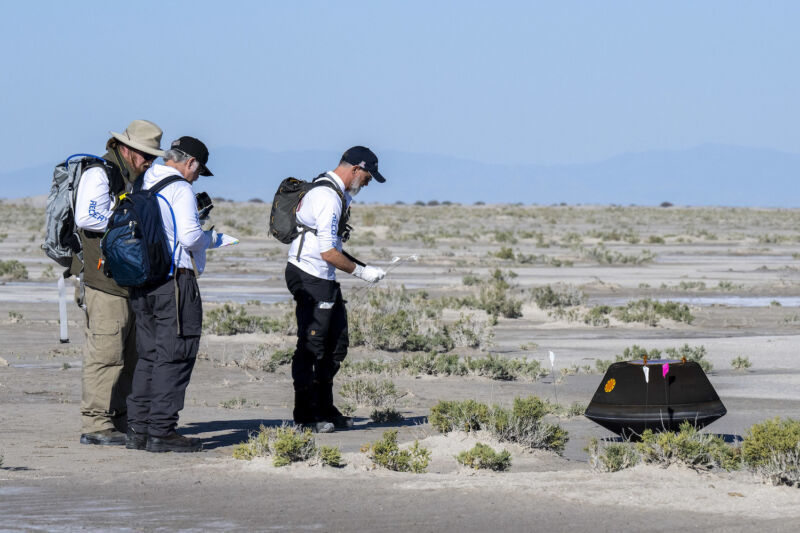
A small capsule carrying pristine specimens from an asteroid parachuted to landing in the Utah desert Sunday, capping a seven-year voyage through the Solar System to bring home samples for eager scientists seeking clues about the origins of life.
NASA's OSIRIS-REx mission brought back the largest unspoiled sample of material ever returned to Earth from beyond the Moon, probably on the order of about 250 grams, or roughly 8 ounces, according to estimates. The spacecraft collected the samples from asteroid Bennu, a loosely-bound rocky world about the size of a small mountain, during a touch-and-go landing in October 2020.
It's the third asteroid sampling mission in history, and the first for the United States, following two Japanese spacecraft that returned a smaller quantity of asteroid specimens to Earth in 2010 and 2020.
OSIRIS-REx was tinged with suspense and drama from start to finish. The project's original lead scientist died in 2011, months after NASA selected his mission concept for funding. In 2016, the spacecraft was stacked on top of its United Launch Alliance Atlas V rocket awaiting liftoff from Cape Canaveral, Florida, when a SpaceX Falcon 9 rocket exploded during a ground test barely a mile away. That sent thick plumes of black smoke over the Atlas V launch pad and briefly knocked offline an air conditioning system needed to keep OSIRIS-REx safe before launch.
Then, in 2020 when OSIRIS-REx collected its sample from Bennu, the spacecraft overfilled its collection chamber. The asteroid was made of much looser material than scientists predicted, so diffuse that the spacecraft could have kept plowing into Bennu had it not performed a pre-planned back-away maneuver.
At the end of its 4-billion-mile celestial journey, the OSIRIS-REx mothership spacecraft released a 32-inch-wide (81-centimeter) sample return capsule early Sunday as it darted toward Earth. More than four hours later, the capsule landed at the US Air Force's Utah Test and Training Range southwest of Salt Lake City at 8:52 am local time (10:52 am EDT or 14:52 UTC).
Scientists working on NASA's $1 billion OSIRIS-REx mission watched anxiously as the capsule came back to Earth, braving temperatures of more than 5,000 degrees Fahrenheit after slamming into the atmosphere at 27,650 mph (12.3 kilometers per second).
Radar sensors and infrared tracking cameras glimpsed the capsule as aerodynamic forces rapidly decelerated the vehicle, subjecting it to 32 times the force of Earth's gravity before an orange and white main parachute opened at an altitude of about 20,000 feet (6,100 meters).
This was about four times higher than predicted, with the chute deployment triggered by a sensor on-board the capsule measuring its deceleration. It wasn't immediately clear whether a drogue parachute meant to stabilize the capsule actually opened before the main chute, as was designed.
In any event, the main parachute did its job and delivered the capsule to the desert surface for a relatively gentle landing at about 10 to 11 mph (17 kilometers per hour). Within minutes, a safety official from the military test range approached the blackened capsule with a safety engineer from Lockheed Martin, which built the OSIRIS-REx spacecraft for NASA.
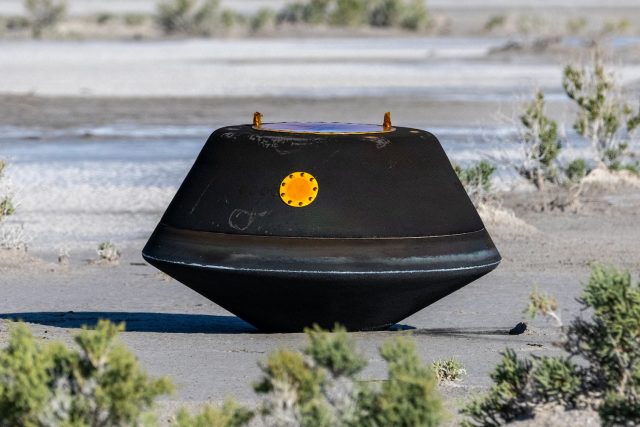
The ground team then wrapped the capsule inside Teflon bags and put it into a safety net under a helicopter, which carried it to a nearby clean room facility at the US Army's Dugway Proving Ground. Technicians there quickly unwrapped the capsule and started disassembling it for transport by cargo plane Monday to NASA's Johnson Space Center in Houston, where scientists inside a specially-built super-clean curation facility will open the lid of the capsule's inner chamber Tuesday.
OSIRIS-REx is an acronym that stands for Origins, Spectral Interpretation, Resource Identification, Security-Regolith Explorer. That's a lot to unpack, but it's sufficient to say the mission is all about bringing asteroid material back to Earth for detailed analyses in research laboratories, which boast capabilities far beyond even the most sophisticated science instrument on a spacecraft.
NASA plans to announce some preliminary findings from the asteroid sample October 11, but more detailed results will take longer. Scientists hope to release the first peer-reviewed research papers analyzing the asteroid specimens by the end of the year, with more results trickling out in 2024. Some of the material will be sent to labs in Canada and Japan, in recognition for those countries' partnership on OSIRIS-REx. A large portion of the specimens will be set aside for future researchers, who may have the benefit of more advanced lab technology.
"Grandfather rocks"
Scientists are eager to find out what OSIRIS-REx captured back in 2020, but observations from the spacecraft's on-board instruments give them some important indicators.
Measurements from OSIRIS-REx, and from telescopes before the mission ever launched, showed Bennu is rich in carbon-based minerals. These are the building blocks of life, and scientists theorize asteroids like Bennu delivered the seeds of life to Earth billions of years ago.
In the chaotic early history of the Solar System, soon after the Sun flashed to life 4.5 billion years ago, a disk of gas and dust around the newborn star started aggregating together—first into grains of dust, then into snowflake-like particles that gradually came together to form asteroids and planets. Scientists think Bennu is a leftover relic from that era.
"The biggest question, the one that drives my scientific investigations, is the origin of life. What is life? How did it originate? And why was it on Earth that it occurred?" said Dante Lauretta, principal investigator on the OSIRIS-REx mission from the University of Arizona. "We believe that we’re bringing back... maybe representatives of the seeds of life that these asteroids delivered at the beginning of our planet, that led to this amazing biosphere, biological evolution, and to us being here today to look back at that amazing history.
“We’re literally looking at geologic materials that formed before the Earth even existed," Lauretta said. "I call these the grandfather rocks, the ones that really represent our origins and where we came from.”
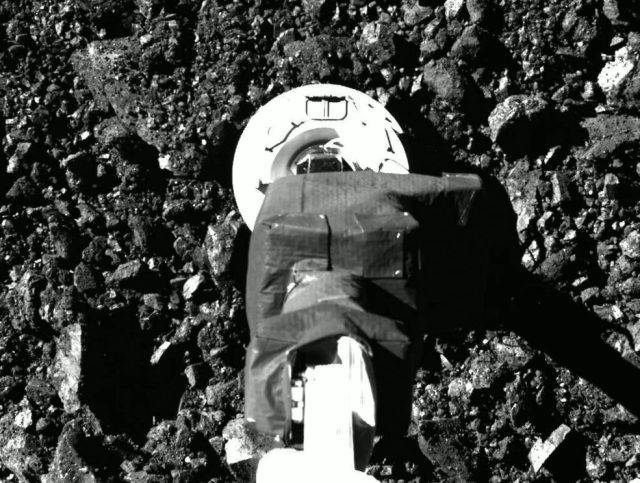
OSIRIS-REx launched from Cape Canaveral aboard an Atlas V rocket on September 8, 2016. It arrived at Bennu at the end of 2018, setting up for the touch-and-go landing two years later. As the spacecraft descended to Bennu, it stuck a robotic arm and a sampling head out in front to grab clumps of rock from the asteroid's surface. The spacecraft sent out a burst of gas to funnel bits of Bennu into a sample collection chamber.
It didn't take long for scientists to realize that Bennu threw them a curveball. The asteroid material at the sampling site was less dense than researchers predicted—about one-sixth the density of a typical rock on Earth—and the touch-and-go landing launched a spray of particles around the spacecraft.
Lauretta compared the dynamics of the sampling run as akin to dropping yourself into a ball pit at a children's playground. "It literally is a droplet made out of rock, gravel, and boulders that are barely held together by their own microgravity.”
So much material went into the sampling system that its lid was wedged open, and smaller pieces of rock started floating out.
That prompted ground teams to accelerate their plan to seal the sampling system inside the return capsule, ensuring no more specimens were lost to space. The capsule is designed like a nesting doll, with a carbon-based ablative heat shield on the outside to protect it from the blistering temperatures of re-entry back into Earth's atmosphere. Inside the heat shield is the sample canister itself, which envelops the sampling head detached from the end of the OSIRIS-REx robot arm.
If it really brought back 250 grams of asteroid material, that is about four times the mission's required sample mass. Scientists won't know the precise mass of the asteroid sample until they transport the canister to a dedicated laboratory in Houston and open it up.
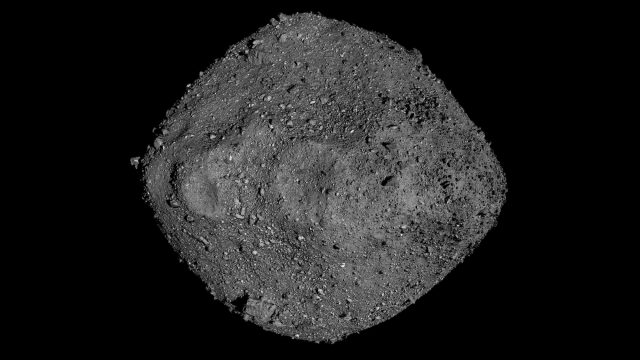
Scientists were thrilled with the successful recovery of OSIRIS-REx samples Sunday, but one more potential snag is on the horizon. The federal government could enter a shutdown if Congress does not pass a new budget and President Biden doesn't sign it by midnight on October 1. With the intense political wrangling in Washington, this appears increasingly likely.
In the event of a government shutdown next month, some of the steps needed to prepare the asteroid sample for analysis will "possibly be delayed," said Lori Glaze, head of NASA's planetary science division.
“We will make sure, first and foremost, that this sample is safe and not at risk," she said. "We have time for that after it returns to Johnson Space Center on September 25. The sample has waited for more than 4 billion years for humans to study it, and if it takes us a little longer, I think we'll be OK.”
Seeds of life
Bennu is classified as a near-Earth asteroid because its orbit around the Sun regularly brings it close to our planet. That made Bennu an attractive target because it's part of the population of asteroids that could threaten Earth, and one that was relatively easy for OSIRIS-REx to reach, in terms of the amount of energy needed to get there and get back home.
Researchers have, for many years, studied carbonaceous meteorites that fell to Earth after breaking off larger asteroids. Those meteorites were scorched as they fell into the atmosphere, and then exposed to Earth's environment for long periods of time until their recovery. The samples from Bennu are unspoiled.
“We’ve been studying meteorites that we think look like Bennu, so I fully expect to find amino acids, the building blocks of proteins, sugars, an energy source for life, nucleobases, parts of the genetic code," said Danny Glavin, a senior scientist for sample return at NASA. "So we’ll see what Bennu tells us. One thing I’ve learned from this mission is (there have been) so many surprises. Sample analysis, probably, won’t be an exception. We're going to be surprised.
“One of the challenges with all meteorites is they get contaminated," Glavin said. "You’re looking for the building blocks of life, and the contamination really makes it hard to tease out what formed in space. That’s why this is so special, these Bennu samples (with) pristine materials. We’re going to be able to trust the organic results from these samples.”
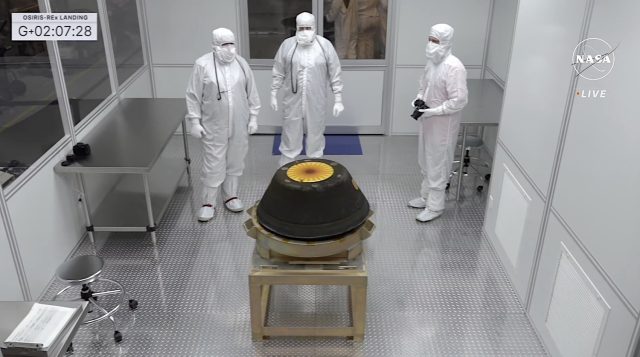
Regardless of the precise composition of the Bennu sample, the material is almost certainly primitive and similar to charcoal in colour, appearing much as it did soon after the formation of the Solar System.
“One of the key objectives of OSIRIS-REx is to characterize any organic molecules that may have been delivered to the early Earth by these carbon-rich bodies," Lauretta said. "We expect that we'll find what we call monomers, or very simple molecules, for example, amino acids, which many people may be familiar with, because they make up our proteins. If you take protein supplements, you can often see the list of amino acids that are included in that."
"What would be really exciting is if we saw any evidence that those amino acids had started to link together to form a chain, which we call peptides," he said. "That would give us some indication that towards the origin of life, protein evolution may have occurred. I want to say that’s a hope. It’s probably a long shot, but it would be a spectacular science result if we were to discover something like that.”
Next stop: Apophis
After releasing its sample return capsule, the OSIRIS-REx mothership fired thrusters to steer away from its collision course with Earth. The spacecraft soared a few hundred miles above the planet, heading back into the Solar System to continue with an extended mission to explore a different asteroid.
This next target, named Apophis, is an elongated asteroid with an average diameter of about 1,100 feet (340 meters). It became one of the Solar System's most famous—infamous?—asteroids soon after its discovery in 2004. At that time, preliminary tracking of the asteroid indicated there was a small chance it could impact Earth on April 13, 2029. Since then, more refined data on the orbit of Apophis have eliminated any chance it will strike Earth for at least the next 100 years.
Apophis is a stony asteroid, different in composition from Bennu. This is the most common type of asteroid that could threaten Earth, so scientists want to learn about Apophis' bulk structure and surface strength. Data collected at Apophis could inform predictions of how much damage a future asteroid impact threat could cause if it impacted Earth.
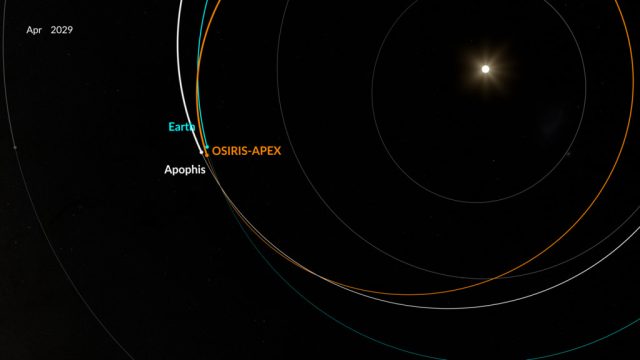
This new extended mission, called OSIRIS-Apophis Explorer (OSIRIS-APEX), will take the spacecraft on several more loops around the Sun. Soon after Apophis passes less than 20,000 miles (32,000 kilometers) from Earth in 2029, the OSIRIS-APEX spacecraft will enter orbit around the asteroid for more than a year of close-up observations.
The spacecraft's time at asteroid Apophis will include another touch-and-go landing, where it will use its thrusters to stir up material and dig into the surface. "This will allow us to observe subsurface material, which will provide otherwise inaccessible insight into space weathering and the surface strength of stony asteroids," researchers at the University of Arizona wrote on the mission's website.
Repurposing the OSIRIS-REx spacecraft for this extended mission is much less expensive than building a new mission to visit Apophis.



3175x175(CURRENT).thumb.jpg.b05acc060982b36f5891ba728e6d953c.jpg)
Recommended Comments
There are no comments to display.
Join the conversation
You can post now and register later. If you have an account, sign in now to post with your account.
Note: Your post will require moderator approval before it will be visible.